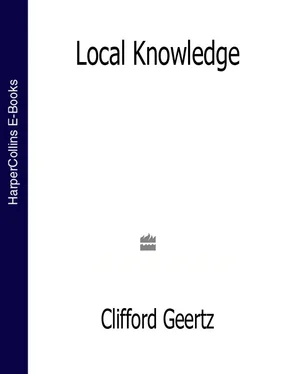Clifford Geertz - Local Knowledge (Text Only)
Здесь есть возможность читать онлайн «Clifford Geertz - Local Knowledge (Text Only)» — ознакомительный отрывок электронной книги совершенно бесплатно, а после прочтения отрывка купить полную версию. В некоторых случаях можно слушать аудио, скачать через торрент в формате fb2 и присутствует краткое содержание. Жанр: unrecognised, на английском языке. Описание произведения, (предисловие) а так же отзывы посетителей доступны на портале библиотеки ЛибКат.
- Название:Local Knowledge (Text Only)
- Автор:
- Жанр:
- Год:неизвестен
- ISBN:нет данных
- Рейтинг книги:4 / 5. Голосов: 1
-
Избранное:Добавить в избранное
- Отзывы:
-
Ваша оценка:
- 80
- 1
- 2
- 3
- 4
- 5
Local Knowledge (Text Only): краткое содержание, описание и аннотация
Предлагаем к чтению аннотацию, описание, краткое содержание или предисловие (зависит от того, что написал сам автор книги «Local Knowledge (Text Only)»). Если вы не нашли необходимую информацию о книге — напишите в комментариях, мы постараемся отыскать её.
Local Knowledge (Text Only) — читать онлайн ознакомительный отрывок
Ниже представлен текст книги, разбитый по страницам. Система сохранения места последней прочитанной страницы, позволяет с удобством читать онлайн бесплатно книгу «Local Knowledge (Text Only)», без необходимости каждый раз заново искать на чём Вы остановились. Поставьте закладку, и сможете в любой момент перейти на страницу, на которой закончили чтение.
Интервал:
Закладка:
Or at least for my own anthropology. The occasion this time was an address to the American Academy of Arts and Sciences in which, as they were giving me an award for my work, I thought I might try to tell them what sort of work it was. The publication of Malinowski’s A Diary in the Strict Sense of the Term several years before had fairly well exploded the notion that anthropologists obtained their results through some special ability, usually called “empathy,” to “get inside the skins” of savages. It is not clear how widely this was ever believed (“The more anthropologists write about the United States,” Bernard De Voto growled when Mead’s And Keep Your Powder Dry came out, “the less we believe what they say about Samoa”); but with the Diary and its revelation of a man so deeply self-engrossed as to suggest he might have been better employed as a romantic poet, the question of how they did obtain them (as Malinowski and, DeVoto notwithstanding, Mead as well so clearly did) demanded to be addressed in less subjectivist terms.
The peoples I have worked among—various sorts of Moroccans and Indonesians; Muslims, Hindus, and one disguised as the other—can hardly be called savages by anybody’s definition; but their approach to things differs enough from one another to put the issue into general focus. To demonstrate this, I first described, rather telegraphically, the concepts of selfhood I had found current in central Java, south Bali, and mid-Atlas Morocco and, even more telegraphically, the broader frames of thought and action in which those conceptions flourished. I then argued that what the anthropologist has to do to bring this kind of thing off is tack between the two sorts of descriptions—between increasingly fine-comb observations (of how Javanese distinguish feelings, Balinese name children, Moroccans refer to acquaintances) and increasingly synoptic characterizations (“quietism,” “dramatism,” “contextualism”)—in such a way that, held in the mind together, they present a credible, fleshed-out picture of a human form of life. “Translation,” here, is not a simple recasting of others’ ways of putting things in terms of our own ways of putting them (that is the kind in which things get lost), but displaying the logic of their ways of putting them in the locutions of ours; a conception which again brings it rather closer to what a critic does to illumine a poem than what an astronomer does to account for a star.
However that may be, it is, this catching of “their” views in “our” vocabularies, one of those things like riding a bicycle that is easier done than said. And in the following two essays I attempt to do a bit of it, in a rather more organized way, for what under some descriptions, though not under mine, would be the antipodal extremes of culture: common sense and art.
Indeed, for many people and most especially for its champions, common sense is not cultural at all, but the simple truth of things artlessly apprehended; plain fact acknowledged by plain men. Thus, I began “Common Sense as a Cultural System,” first given as a John Dewey Lecture at Antioch College in the middle of a sixties uprising, by arguing, contrary to this (com-monsensical) idea, that common sense was a cultural system; a loosely connected body of belief and judgment, rather than just what anybody properly put together cannot help but think. There may be things that anybody properly put together cannot help but think—that rocks are hard and death inevitable. And there certainly are some—that rocks are insentient and death disagreeable—that, though Wordsworth gave a moral life to stones and Fascist thugs shouted viva la muerte at Unamuno, no one much doubts. But common sense has more to do with how to deal with a world in which such things obtain than with the mere recognition that they do so. Common sense is not a fortunate faculty, like perfect pitch; it is a special frame of mind, like piety or legalism. And like piety or legalism (or ethics or cosmology), it both differs from one place to the next and takes, nevertheless, a characteristic form.
The rest of the essay then seeks to illustrate all this, first with some examples taken from the anthropological literature (Evans-Pritchard on witchcraft, Edgerton on hermaphroditism) to display the variation, and then with some features seen as distinctive of common sense in whatever clime (distrust of subtlety, exaltation of the practical, and so forth) to expose the form. The oscillation between looking particulately at particular views and defining globally the attitude that permeates them thus governs again the progress of analysis. Only here there is an attempt to push things on to broader issues: the construction of anthropological categories, the generality of their reference, and the conditions of their use.
When one turns to art these issues become, if anything, even more pointed, for the debate over whether it is an applicable category in “non-Western” or “pre-Modern” contexts has, even when compared to similar debates concerning “religion,” “science,” “ideology,” or “law,” been peculiarly unrelenting. It has also been peculiarly unproductive. Whatever you want to call a cave wall crowded with overlapping images of transfixed animals, a temple tower shaped to a phallus, a feathered shield, a calligraphic scroll, or a tattooed face, you still have the phenomenon to deal with, as well as perhaps the sense that to add kula exchange or the Domesday Book would be to spoil the series. The question is not whether art (or anything else) is universal; it is whether one can talk about West African carving, New Guinea palm-leaf painting, quattrocento picture making, and Moroccan versifying in such a way as to cause them to shed some sort of light on one another.
The essay in which I tried to do exactly this, “Art as a Cultural System,” was delivered at Johns Hopkins University as part of a wildly multidiscipli-nary symposium—Maurice Mandlebaum, Paul de Man, and Alan Dundes to Umberto Eco, Thomas Sebeok, and Roman Jakobson—on “semiotics” (the occasion being a commemoration of Charles Peirce, whom the University had at one time fired), with the result that I was almost as much concerned with how not to talk about such things—in terms of some sort of mechanical formalism—as I was with developing my own approach. In particular, the identification of semiotics, in the general sense of the science of signs, with structuralism seemed to me important to resist. (Structuralism, as a sort of high-tech rationalism, seems to me important to resist in general.) And so I employed my cases—Robert Fans Thompson’s analysis of Yoruba line, Anthony Forge’s of Abelam color, Michael Baxandall’s of Renaissance composition, and my own of Moroccan rhetoric—to suggest that the social contextualization of such “signifiers” is a more useful way to comprehend how they signify, and what, than is forcing them into schematic paradigms or stripping them down to abstract rule systems that supposedly “generate” them. What enables us to talk about them usefully together is that they all inscribe a communal sensibility, present locally to locals a local turn of mind.
Like common sense—or religion or law or even, though it is, given our predilections, a touchier matter, science—art is neither some transcendent phenomenon variously disguised in different cultures nor a notion so thoroughly culture-bound as to be useless beyond Europe. Not only Sweeney’s Law (“I gotta use words when I talk to ya”) but the simple fact that thinking of Noh plays and operas, or Shalako and L’Oiseau de feut in relation to one another seems a more profitable thing to do than to think of any of them in relation to canoe building or the Code Civil (though, remembering Zen and motorcycle maintenance, one ought not to be too sure) suggest that radical culturalism will get us nowhere. And the impossibility of collapsing these so very different things into one another at any but the most abstract, and vacuous, levels—“objects of beauty,” “affective presences,” “expressive forms”—suggests that a universalist tack is hardly more promising. The reshaping of categories (ours and other people’s—think of “taboo”) so that they can reach beyond the contexts in which they originally arose and took their meaning so as to locate affinities and mark differences is a great part of what “translation” comes to in anthropology. It is—think of what it has done to “family,” “caste,” “market,” or “state”—a great part of what anthropology comes to.
Читать дальшеИнтервал:
Закладка:
Похожие книги на «Local Knowledge (Text Only)»
Представляем Вашему вниманию похожие книги на «Local Knowledge (Text Only)» списком для выбора. Мы отобрали схожую по названию и смыслу литературу в надежде предоставить читателям больше вариантов отыскать новые, интересные, ещё непрочитанные произведения.
Обсуждение, отзывы о книге «Local Knowledge (Text Only)» и просто собственные мнения читателей. Оставьте ваши комментарии, напишите, что Вы думаете о произведении, его смысле или главных героях. Укажите что конкретно понравилось, а что нет, и почему Вы так считаете.










![Brian Thompson - A Monkey Among Crocodiles - The Life, Loves and Lawsuits of Mrs Georgina Weldon – a disastrous Victorian [Text only]](/books/704922/brian-thompson-a-monkey-among-crocodiles-the-life-thumb.webp)

